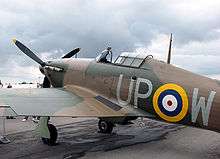Hawker Aircraft
| Industry | Aviation |
|---|---|
| Fate | Merged into Hawker Siddeley Group |
| Successor | Hawker Siddeley |
| Founded | 1920 (as H G Hawker Engineering) |
| Defunct | 1963 |
| Headquarters | Kingston upon Thames, Greater London, England, UK |
Number of locations | Langley; Dunsfold; Blackpool, England, UK |
Key people | Harry Hawker, Thomas Sopwith, Sydney Camm |
| Subsidiaries | Gloster Aircraft Company (1934) |
Hawker Aircraft Limited was a British aircraft manufacturer responsible for some of the most famous products in British aviation history.
History
Hawker had its roots in the aftermath of the First World War which resulted in the bankruptcy of the Sopwith Aviation Company. Sopwith test pilot Harry Hawker and three others, including Thomas Sopwith, bought the assets of Sopwith and formed H.G. Hawker Engineering in 1920.
In 1933 the company was renamed Hawker Aircraft Limited and took advantage of the Great Depression and a strong financial position to purchase the Gloster Aircraft Company in 1934. The next year it merged with the engine and automotive company Armstrong Siddeley and its subsidiary, Armstrong Whitworth Aircraft, to form Hawker Siddeley Aircraft. This group also encompassed A. V. Roe and Company; Avro.
Hawker Aircraft continued to produce designs under its own name as a part of the Hawker Siddeley Aircraft, from 1955 division of Hawker Siddeley Group. The "Hawker" brand name was dropped, along with those of the sister companies, in 1963. The Hawker P.1127 was the last aircraft branded as "Hawker".
The Hawker legacy was maintained by the American company Raytheon who produced business jets (including some derived from the 125, whose original design dated back to de Havilland days) under the "Hawker" name. This was the result of purchasing British Aerospace's product line in 1993. The name is currently used by Hawker Beechcraft after Raytheon's business jet interests (Hawker and Beechcraft) were acquired by investors and merged.
Products

In the interwar years, Hawker produced a successful line of bombers and fighters for the Royal Air Force, the product of Sydney Camm (later Sir Sydney) and his team. These included the Hawker Hind and the Hawker Hart, which became the most produced UK aeroplane in the years before the Second World War.
During the Second World War, the Hawker Siddeley company was one of the United Kingdom's most important aviation concerns, producing numerous designs including the famous Hawker Hurricane fighter plane that, along with the Supermarine Spitfire, was instrumental in winning the Battle of Britain. (During the battle, Hawker Hurricanes in service outnumbered all other British fighters combined, and were responsible for shooting down 55 percent of all enemy aircraft destroyed.)
List
- This transport-related list is incomplete; you can help by expanding it.
- Hawker Duiker 1923 prototype First original design by Hawker, 1 aircraft built, J6918[1][2]
- Hawker Woodcock 1923
- Hawker Cygnet 1924
- Hawker Hedgehog 1924 prototype
- Hawker Horsley 1925
- Hawker Heron 1925
- Hawker Hornbill 1925
- Hawker Danecock 1925
- Hawker Harrier 1927 prototype
- Hawker Hawfinch 1927
- Hawker Hart 1928
- Hawker F.20/27 1928 prototype
- Hawker Hoopoe 1928
- Hawker Tomtit 1928
- Hawker Hornet 1929
- Hawker Osprey 1929
- Hawker Nimrod 1930
- Hawker Fury 1931
- Hawker Fury variants
- Hawker Audax 1931
- Hawker Dantorp1932
- Hawker Demon 1933
- Hawker P.V.3 1934 prototype
- Hawker Hardy 1934
- Hawker Hind 1934
- Hawker Hind variants
- Hawker P.V.4 1934 prototype
- Hawker Hartbees 1935
- Hawker Hurricane 1935
- Hawker Hector 1936
- Hawker Henley 1937
- Hawker Hotspur 1938
- Hawker Tornado 1939
- Hawker Typhoon 1940
- Hawker Tempest 1942
- Hawker F.2/43 Fury 1943 Prototype
- Hawker Sea Fury 1944
- Hawker P.1040 1947 Prototype
- Hawker Sea Hawk 1947
- Hawker P.1052 1948 Prototype
- Hawker P.1072 1950 Prototype
- Hawker P.1078 Prototype
- Hawker P.1081 1950 Prototype
- Hawker Hunter 1951
- Hawker P.1103 1950s prototype
- Hawker P.1121 Late 1950s prototype
- Hawker P.1127 1960 Prototype
- Hawker P.1214
Key People
Aircraft Designers and Engineers
Chief Test Pilots
See also
References
Citations
Bibliography
- Hannah, Donald. Hawker FlyPast Reference Library. Stamford, Lincolnshire, UK: Key Publishing Ltd., 1982. ISBN 0-946219-01-X.
- James, Derek N. Hawker, an Aircraft Album No. 5. New York: Arco Publishing Company, 1973. ISBN 0-668-02699-5. (First published in the UK by Ian Allan in 1972)
- Mason, Francis K. Hawker Aircraft since 1920. London: Putnam & Company, 3rd revised edition 1991. ISBN 0-85177-839-9.
External links
| Wikimedia Commons has media related to Hawker aircraft. |